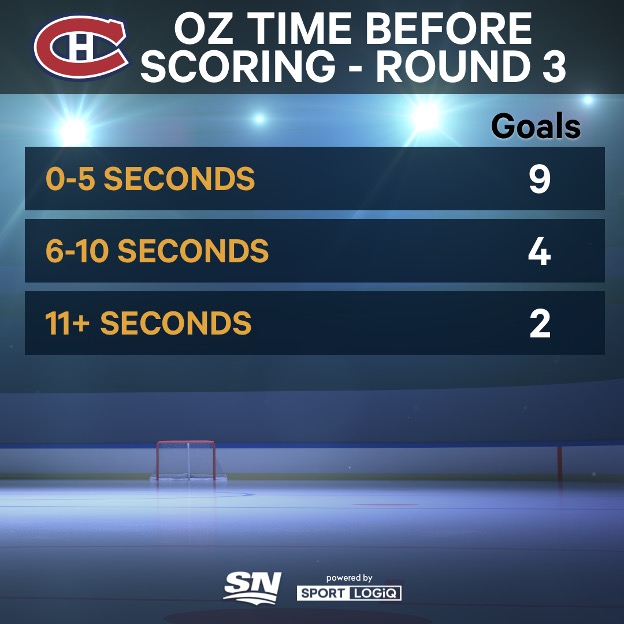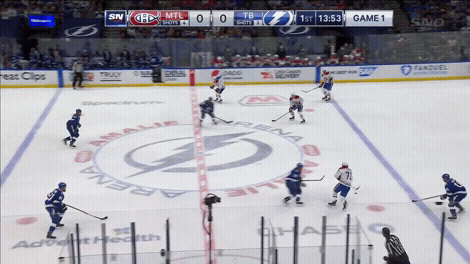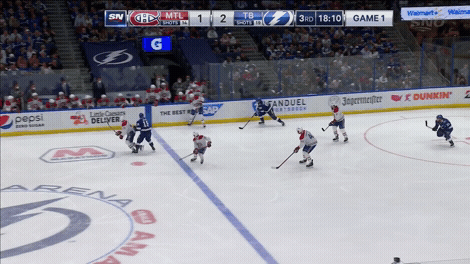The Montreal Canadiens have been correctly defined as a group that has had success on the backs of its team play, as opposed to that of a few elite individuals. And when you think of teams that have done that in the past, you tend to think of teams who “keep it simple” and “do it the right way,” both of which makes you think about stultifying defence and a “pucks in deep” style offence.
The latter one there hasn’t exactly been the Montreal Canadiens, who haven’t at all found their offence via dump-ins and grinding cycle play. In fact, they’re last in 5-on-5 offensive zone possession time through the playoffs, leaning instead on quick strike transitions to score their goals.
That’s been made possible by how they’ve played without the puck.
While the Habs do forecheck with typical NHL aggressiveness from within a 1-2-2 system, they’ve been content to play a patient brand of defensive hockey through the neutral zone. There they employ a 1-1-3 that may allow the opposition the ability to move the puck across the centre red line, but rarely allows them speed and opportunity off the rush.
Video clips rarely unfold in perfect X’s and O’s fashion, but you can see they have their D ready to step up at the blue line, knowing there’s a Habs forward coming back to help if any pinch attempt goes wrong.
They’ve combined that sticky rush defence with elite goaltending, meaning that even when teams have earned offensive zone time against them, Carey Price and crew have been able to keep the puck out of their net. From there it’s just been a question of scoring enough goals, which brings us back to that transition play (which is often made easier by the way they defend their own blue line).
The Habs have been wildly opportunistic in the post-season, and I think part of their ability to play that way has come from the underdog mindset. When nothing is happening for favourites those teams can start to get desperate and force plays, but when you’re not “supposed” to win, close games are less something to fear and more something to revel in. It’s allowed Montreal to wait for their spots and then go.
To get a sense for how much of their offence has been driven by transition play, just look at the 15 goals they scored against Vegas last series. Mike Kelly of SportLogiq and the NHL Network broke it down in an article for Sportsnet with this graphic:

A whopping 13 of Montreal's 15 goals against Vegas came less than 10 seconds after they crossed the opposition's blue line. It’s been working great.
So far.
The problem here is that Tampa Bay is also excellent at defending their own blue line and less excellent (still not bad, but less excellent) once the opposition gets set up with sustained O-zone time in their end … which is basically the opposite of what’s worked for Montreal so far. As I mentioned earlier, “O-zone time” isn’t really a thing the Canadiens have been getting in the playoffs.
What’s different about Tampa’s rush defence is two-fold. One is that their defencemen are big and mobile, which helps, but the important part is that they get consistent back pressure from almost every one of their forwards. Like, we know Mark Stone generally does it exceedingly well for Vegas, but they had a few other players (like Tomas Nosek, who I wrote about here), who didn’t come back with the same ferocity.
Brayden Point, Ondrej Palat, Alex Killorn (out for Game 2), Yanni Gourde, Anthony Cirelli, Tyler Johnson, Barclay Goodrow, Blake Coleman -- honestly it’s hard to find a forward who doesn’t make a concerted effort going both ways for the Lightning.
In Game 1 Montreal wanted to continue to threaten off the rush as they have so far in the playoffs, which bit them.
On the first goal, it’s Point coming back with pressure to break up the rush and launch Tampa Bay’s counter.

On the second goal, Gourde’s back pressure helps create the blue line squeeze that leads to a forced play, and kickstarts the Lightning going the other way.

And on the third goal, the direction of Kucherov and Palat (back towards their own net) affords Mikhail Sergachev the freedom to step up and break up a rush before it can get a breath of life.

So what you’ve got here is two teams that defend the transition well, only the Lightning sneakily play more of a chip-and-chase style on offence than you’d think, which gives them an advantage in this department. They look to make stretch passes in transition as well, but when it’s not there, they’ll put it in the zone and get after it. Thus far, Montreal hasn’t had to do that.
Are they comfortable doing that? Are they willing to get away from what’s been working for them so far in this post-season?
This is one of those things that’s so great about the Stanley Cup Playoffs, and why it gets labelled the hardest trophy to win. You almost always run into some team that asks you to play a style that isn’t your preferred one, meaning you have to be able to excel in a variety of ways.
This hasn’t been a strength of the Habs' so far. That doesn’t mean it can’t be, it just has to be an adjustment early in this series before it gets away from them. Frankly, it’s one of the easiest adjustments to make, because you’re asking your guys to make simple plays and work hard (which, granted, is easier in Round 1 than Round 4).
If Montreal intends to just sit back and clog things up and wait for their chances against the Tampa Bay Lightning, they may never come, or at least not frequently enough. Being opportunistic is good, but it can’t be the game plan heading into Game 2 tonight.
